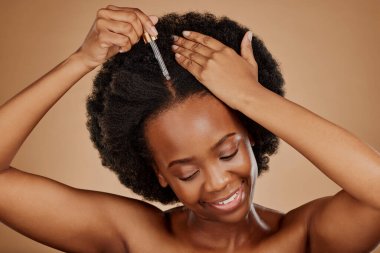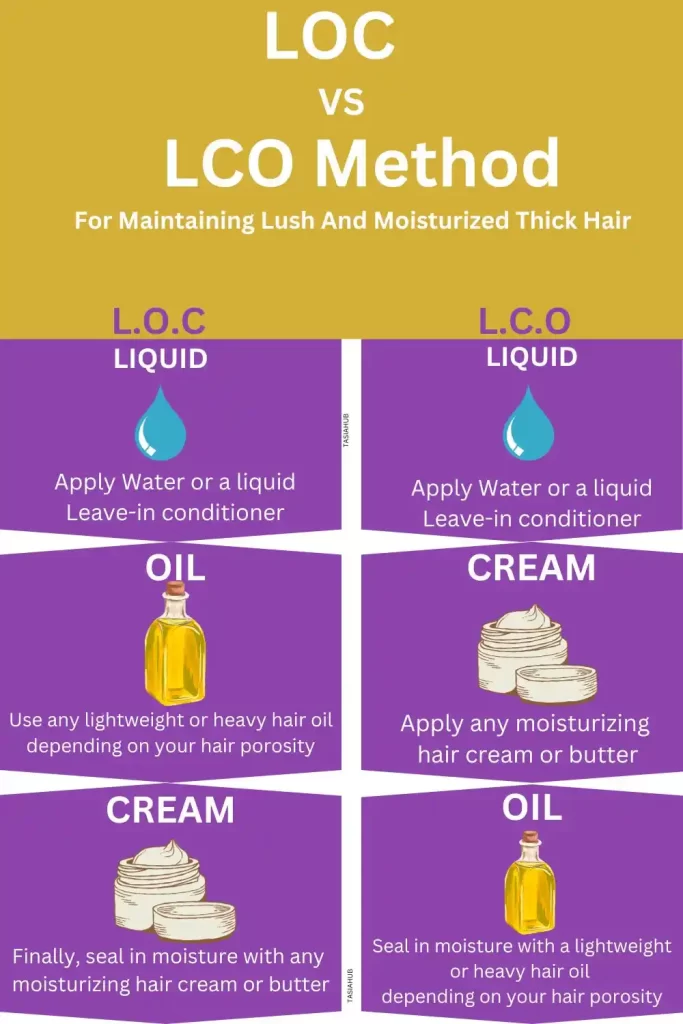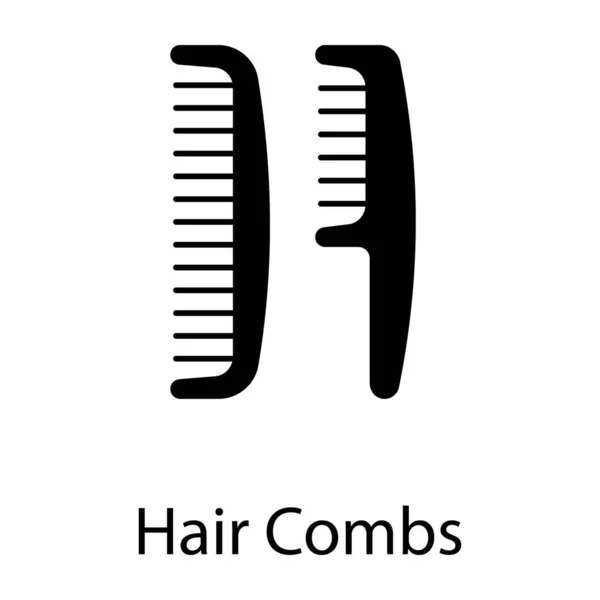LOC Method for 4C Hair: The Ultimate Guide to Hydration and Moisture Retention

When caring for 4C hair, finding effective methods to moisturize and retain moisture is essential. One technique that has gained popularity among natural hair enthusiasts is the LOC method.
The LOC method, which stands for Liquid, Oil, and Cream, is a simple yet effective way to ensure that your hair stays hydrated and nourished for longer periods.
LOC method for moisture retention is by far the most effective moisturizing technique for 4C hair, it is an effective technique for sealing in moisture which is necessary for 4C hair growth.
This post contains affiliate links and I may earn a small commission when you click on the link at no additional cost to you. As an Amazon Affiliate, I earn from qualifying purchases, thank you.
Ever since I did my big chop in February 2023, I religiously used this method for sealing in moisture in my 4C hair, and it has proven itself to be a significant change in my 4C hair care routine.
In this comprehensive guide, we will explore the ins and outs of the LOC method for 4C hair, including how it works, how to effectively apply products, and how to adjust the method based on your hair’s porosity levels.
Understanding the LOC Method for 4C Hair

What is the LOC Method for 4C Hair?
The LOC method is a three-step process that involves layering different products on your hair to seal in moisture. The first step, Liquid, refers to using a water-based product or simply water itself as the base for moisturizing your hair. This helps to hydrate the hair shaft and prepare it for the next steps.
The second step, Oil, involves applying a lightweight moisturizing oil to seal in the moisture and prevent it from escaping. Finally, the third step, Cream, entails using a creamy or butter-based product to lock in the moisture and provide additional nourishment to your hair.
This method should be used on a clean scalp to avoid product buildup.
How Does the LOC Method Work for 4C Hair?
The LOC method is particularly beneficial for 4C hair, which tends to be more prone to dryness, breakage, and tangles. This hair type requires extra care and moisture to maintain its health and vitality.
The LOC method works by creating a barrier around the hair shaft, preventing moisture loss and allowing the hair to retain hydration for longer periods. By layering the products in the correct order, you can effectively moisturize and seal in moisture in your 4C hair, promoting softness, manageability, and overall hair health.
Benefits of the LOC Method for 4C Hair
The benefits of the LOC method for 4C hair are numerous. By following this technique, you can:
- Retain Moisture: The layering of products in the LOC method helps to lock in moisture, preventing dryness and promoting long-lasting hydration in your 4C hair.
- Improve Manageability: Hydrated hair is easier to manage and style. The LOC method ensures that your 4C hair is well-moisturized, making it more pliable and less prone to breakage during styling.
- Enhance Curl Definition: Proper moisture balance achieved through the LOC method can help define and enhance your natural curl pattern, giving your 4C hair a more defined and voluminous look.
- Prevent Breakage: Dry, brittle hair is more prone to breakage. The LOC method provides the necessary moisture and sealant to protect your 4C hair from breakage, promoting length retention.
- Promote Hair Growth: When your hair is properly moisturized and protected, it creates a conducive environment for hair growth. The LOC method helps to maintain the optimal moisture balance needed for healthy hair growth.
How to Effectively Apply the LOC Method on 4C Hair
To achieve the best results with the LOC method for 4C hair, it’s important to follow the correct order of application and choose suitable products for each step. Here is a step-by-step guide on how to effectively apply the LOC method:
Step 1: Liquid (Moisturizer)
The first step in the LOC method is to apply a liquid-based moisturizer to your hair. This can be a water-based leave-in conditioner or simply plain water. The liquid serves as the foundation for moisturizing your hair and preparing it to receive the subsequent products.
It’s important to ensure that your liquid is hydrating and suits your hair’s needs. Apply the liquid evenly throughout your hair, focusing on the ends, which tend to be the driest.
Step 2: Oil (Sealant)
Once your hair is moisturized with the liquid, it’s time to seal in the moisture with a lightweight oil. Choose an oil that penetrates the hair shaft effectively, such as coconut oil, argan oil, or jojoba oil.
These oils provide an occlusive barrier, preventing moisture loss and promoting hair health. Apply a small amount of oil to your hair, focusing on the ends and any areas that are prone to dryness or breakage.
Step 3: Cream (Lock-in)
The final step in the LOC method is to apply a cream-based product to lock in the moisture and provide additional nourishment to your 4C hair. Look for a cream or butter-based moisturizer rich in natural ingredients like shea butter, cocoa butter, or mango butter.
These ingredients help to seal the cuticle and keep your hair moisturized for longer periods. Apply the cream evenly throughout your hair, paying extra attention to the ends.
Hair porosity plays a pivotal role in the effectiveness of hair care routines, particularly for those with 4C hair. Understanding how hair porosity interacts with the LOC (Liquid, Oil, Cream) method is crucial for tailoring a regimen that meets the unique needs of 4C hair textures.
Hair Porosity and LOC Method for 4C Hair
1. Decoding Hair Porosity:
- Low Porosity: 4C hair with low porosity has a cuticle layer that is tightly bound, making it resistant to moisture absorption. As a result, it’s essential to use lightweight products and, in the context of the LOC method, consider less frequent oil application to prevent buildup.
- High Porosity: High porosity 4C hair, on the other hand, has a more porous cuticle layer, making it prone to losing moisture quickly. For this hair type, the LOC method can be intensified, with more frequent oil sealing to help retain moisture.
Low porosity hair may benefit from lighter oils like jojoba or grapeseed, while high porosity hair might require heavier oils such as castor or olive oil.
Detangling in Each LOC Step
Detangling is an important aspect of any hair care routine, especially for 4C hair, which tends to be more prone to tangles and knots. To ensure effective detangling while following the LOC method, it’s recommended to detangle your hair in each step.
Use a wide-toothed comb or detangling brush to gently remove any knots or tangles before applying each product. This helps to distribute the products evenly and prevents further damage or breakage during the process.
Gentle Detangling for 4C Hair
When detangling your 4C hair, it’s crucial to be gentle and patient. Start detangling from the ends of your hair and work your way up to the roots, using your fingers or a wide-toothed comb.

Avoid pulling or tugging on your hair, as this can lead to breakage. If you encounter stubborn knots or tangles, apply a small amount of oil or conditioner to the area and use your fingers or a detangling brush to gently work through the knot.
Remember to take your time and be gentle, as 4C hair requires extra care and attention during the detangling process.
Choosing the Right Sealant for Your Hair
The choice of sealant in the LOC method plays a significant role in the effectiveness of moisture retention. Different hair types and porosity levels may require varying types of sealants.
For 4C hair, which tends to have higher porosity, it’s important to choose a sealant that is rich and moisturizing. Natural butter like shea butter, mango butter, or cocoa butter work well as sealants for 4C hair, as they provide intense hydration and seal in the moisture effectively.
Benefits of Protective Styles in Conjunction with the LOC Method
Incorporating protective styles into your hair care routine can greatly enhance the effectiveness of the LOC method for 4C hair. Protective styles, such as braids, twists, buns, or wigs, help to minimize manipulation and protect your hair from external factors that can cause moisture loss.

By combining the LOC method with protective styling, you create an optimal environment for moisture retention and hair growth. These styles also help to reduce breakage and promote length retention in 4C hair.
Preserving Moisture Overnight: LOC Method for Bedtime
Maintaining moisture in your hair overnight is essential for healthy hair. To preserve the moisture achieved through the LOC method, it’s important to adopt a nighttime routine that promotes hydration.
Sleeping with a satin or silk bonnet or scarf is an effective way to preserve moisture overnight. These materials help to minimize friction and moisture loss, allowing your hair to retain its hydration and preventing frizz and dryness. Additionally, using a satin or silk pillowcase can also aid in preserving moisture and reducing friction while you sleep.
Adapting the LOC Method for Changing Seasons
As the seasons change, so do the needs of your hair. It’s important to adapt your hair care routine, including the LOC method, to accommodate the changing environmental conditions.
For example, during the winter months, when the air tends to be drier, you may need to use heavier oils and creams to provide extra protection and moisture.
In contrast, during the summer months, when the air is more humid, you may opt for lighter oils and creams to avoid weighing down your hair. Pay attention to how your hair responds to different products and adjust your LOC method accordingly.
Consistency is Key: Tracking Progress with the LOC Method
Consistency is key when it comes to the LOC method. To track your progress and determine the method’s effectiveness for your 4C hair, it’s important to observe and document any changes in your hair’s moisture levels, manageability, and overall health.
Keep a hair care journal or take regular progress photos to monitor the condition of your hair over time. This will help you identify any adjustments that may be needed in your product choices or application techniques to optimize the results of the LOC method.
Adjusting the LOC Method for Optimal Results
Every individual’s hair is unique, and what works for one person may not work for another. It’s important to listen to your hair and make adjustments to the LOC method as needed.
This can include experimenting with different products, adjusting the order of application, or modifying the frequency of application based on your hair’s needs. Pay attention to how your hair responds to the LOC method and make changes accordingly to achieve optimal results.
How Often Should You Do the LOC Method on 4C Hair?
Maintaining optimal moisture levels is crucial for the health and vitality of 4C hair, and the LOC (Liquid, Oil, Cream) method is a popular regimen for achieving this. However, determining how often to perform the LOC method depends on several factors, including your hair’s unique characteristics, lifestyle, and environmental conditions.
1. Hair Porosity:
- Low Porosity Hair: If your 4C hair has low porosity, it may be resistant to absorbing moisture. In this case, performing the LOC method less frequently, such as once or twice a week, might be sufficient to prevent product buildup.
- High Porosity Hair: High porosity hair tends to lose moisture more quickly. Individuals with high porosity 4C hair may benefit from more frequent LOC sessions, perhaps 2-3 times a week, to help retain moisture.
2. Lifestyle Factors:
- Active Lifestyle: If you engage in activities that expose your hair to elements like wind, sun, or chlorine (e.g., swimming), you may need to do the LOC method more frequently to counteract moisture loss.
- Protective Styling: When wearing protective styles such as braids or twists, the frequency of the LOC method can be adjusted. Some find that a bi-weekly routine is sufficient, while others prefer to do it more frequently, depending on how well their hair retains moisture.
3. Climate and Seasonal Changes:
- Dry Climates: In dry climates, where moisture loss is more rapid, you may need to increase the frequency of the LOC method. This might involve performing it every 2-3 days to ensure consistent hydration.
- Humid Climates: In humid conditions, where the air is naturally moist, you may find that your 4C hair retains moisture for longer. Adjust the frequency based on the specific needs of your hair in that environment.
4. Observing Your Hair’s Response:
- Hydration Levels: Pay attention to how well your hair retains moisture between LOC sessions. If your hair feels consistently dry, you may need to increase the frequency. If it feels overly weighed down or greasy, you might be applying the LOC method too often.
There is no one-size-fits-all answer to how often you should do the LOC method on 4C hair. It’s essential to tailor your routine based on your hair’s unique characteristics and the external factors it’s exposed to.
Regularly assess the condition of your hair and adjust the frequency accordingly. Finding the right balance will help you maintain healthy, moisturized 4C hair over the long term.
Which Method is Better: LCO or LOC?
When it comes to caring for natural hair, particularly the tight coils of 4C hair, the debate between the LCO (Liquid, Cream, Oil) and LOC (Liquid, Oil, Cream) methods is a common and nuanced discussion. Both methods aim to moisturize and seal the hair to prevent dryness and breakage, but they differ in the order of product application. Let’s delve into the details to help you decide which method might be better suited for your 4C hair care routine.
1. Understanding the LCO Method:
- Liquid: The process begins with applying a water-based or liquid leave-in conditioner. This step helps to hydrate and soften the hair, preparing it for the next layers.
- Cream: Following the liquid, a creamy moisturizer is applied to further enhance hydration. Creams often contain emollients and humectants to lock in moisture.
- Oil: The final step involves sealing in the moisture with an oil. This creates a protective barrier to prevent water loss, keeping the hair moisturized for an extended period.
2. Exploring the LOC Method:
- Liquid: Similar to the LCO method, the LOC method starts with a water-based product or leave-in conditioner to moisturize the hair.
- Oil: The second step involves applying an oil to lock in the moisture. This step is crucial for individuals with highly porous hair, as it helps prevent moisture loss.
- Cream: The final step is the application of a cream or butter-based product to further seal the moisture and provide additional nourishment.
3. Factors to Consider:
- Hair Porosity: Individuals with low porosity hair may find the LCO method more effective, as the oil layer helps to penetrate the hair shaft. High porosity hair, on the other hand, might benefit more from the heavier sealing of the LOC method.
- Climate and Season: The choice between LCO and LOC can be influenced by the climate. In drier climates, the LOC method might be preferred for its heavier sealing properties.
- Personal Preference: Ultimately, the better method depends on personal preference. Some individuals find that one method works better for their hair type and lifestyle.
4. Experimenting and Adaptation:
- Trial and Error: It’s essential to experiment with both methods to determine which one yields the best results for your unique hair characteristics.
- Adaptation: Your hair’s needs may change over time. Consider adapting your routine based on seasonal changes, lifestyle adjustments, or changes in hair health.
The choice between LCO and LOC is subjective and depends on various factors, including hair porosity, climate, and personal preference. Experiment with both methods, observe how your hair responds, and tailor your routine to meet the specific needs of your 4C hair.
Whether you choose LCO or LOC, consistency and attention to your hair’s characteristics are key to achieving a healthy and moisturized mane.
What to Do When the LOC Method for 4C Hair Doesn’t Work
Despite the widespread success of the LOC (Liquid, Oil, Cream) method in providing moisture and enhancing the health of 4C hair, there may be instances where the results fall short of expectations. If you find that the LOC method doesn’t seem to work as effectively for your 4C hair, consider the following troubleshooting steps:
1. Reassess Your Technique:
- Application Order: Confirm that you are correctly following the LOC method’s sequence—starting with a liquid, followed by oil, and finishing with a cream. The order is crucial for optimal moisture retention.
- Product Saturation: Ensure that each product is evenly distributed throughout your hair. Incomplete coverage may lead to uneven moisture distribution and less effective sealing.
2. Evaluate Product Choices:
- Product Compatibility: Assess whether the products you’re using are suitable for your hair’s unique needs. Consider experimenting with different brands or formulations to find the combination that works best for your 4C hair.
- Ingredient Awareness: Pay attention to product ingredients. Some ingredients may not be well-suited for certain hair types, and your hair might respond better to products with specific formulations.
3. Consider Adjusting Product Types:
- Lighter vs. Heavier Oils: Depending on your hair’s porosity, you may need to adjust the type of oil used. Low porosity hair may benefit from lighter oils, while high porosity hair might require heavier options.
- Cream Consistency: The cream used should match your hair’s texture and density. Experiment with different consistencies, such as butter-based creams or lighter leave-in conditioners, to find the right fit.
4. Evaluate Hair Porosity:
- Porosity Assessment: Reevaluate your hair’s porosity. If you’ve incorrectly identified your hair’s porosity level, it might impact the effectiveness of the LOC method. Adjust your approach based on accurate porosity information.
5. Adapt to Seasonal Changes:
- Climate Considerations: The effectiveness of the LOC method can be influenced by seasonal changes. Adjust the frequency or products used based on environmental factors such as humidity or dry weather.
6. Consider Professional Guidance:
- Consult a Stylist: If challenges persist, seek advice from a professional hairstylist or a trichologist. They can provide personalized insights into your hair’s needs and recommend adjustments to your hair care routine.
7. Be Patient and Persistent:
- Give it Time: Hair care routines often require time for noticeable changes. Be patient and consistent with the LOC method, allowing sufficient time for your hair to adapt and respond positively.
The LOC method may need fine-tuning to align with the specific characteristics of your 4C hair. By reassessing your technique, experimenting with product choices, and considering your hair’s unique needs, you can troubleshoot and optimize the LOC method for a more effective and satisfying hair care routine.
Conclusion
The LOC method is a proven technique for moisturizing and retaining moisture in 4C hair. By following the correct order of application and choosing suitable products for each step, you can effectively hydrate and nourish your hair, promoting softness, manageability, and overall hair health.
Remember to detangle gently, choose the right sealant for your hair, incorporate protective styles, and adapt the method to changing seasons. Consistency and flexibility are key to achieving optimal results with the LOC method for 4C hair. Embrace the journey of caring for your hair and enjoy the benefits of healthy, hydrated locks.
